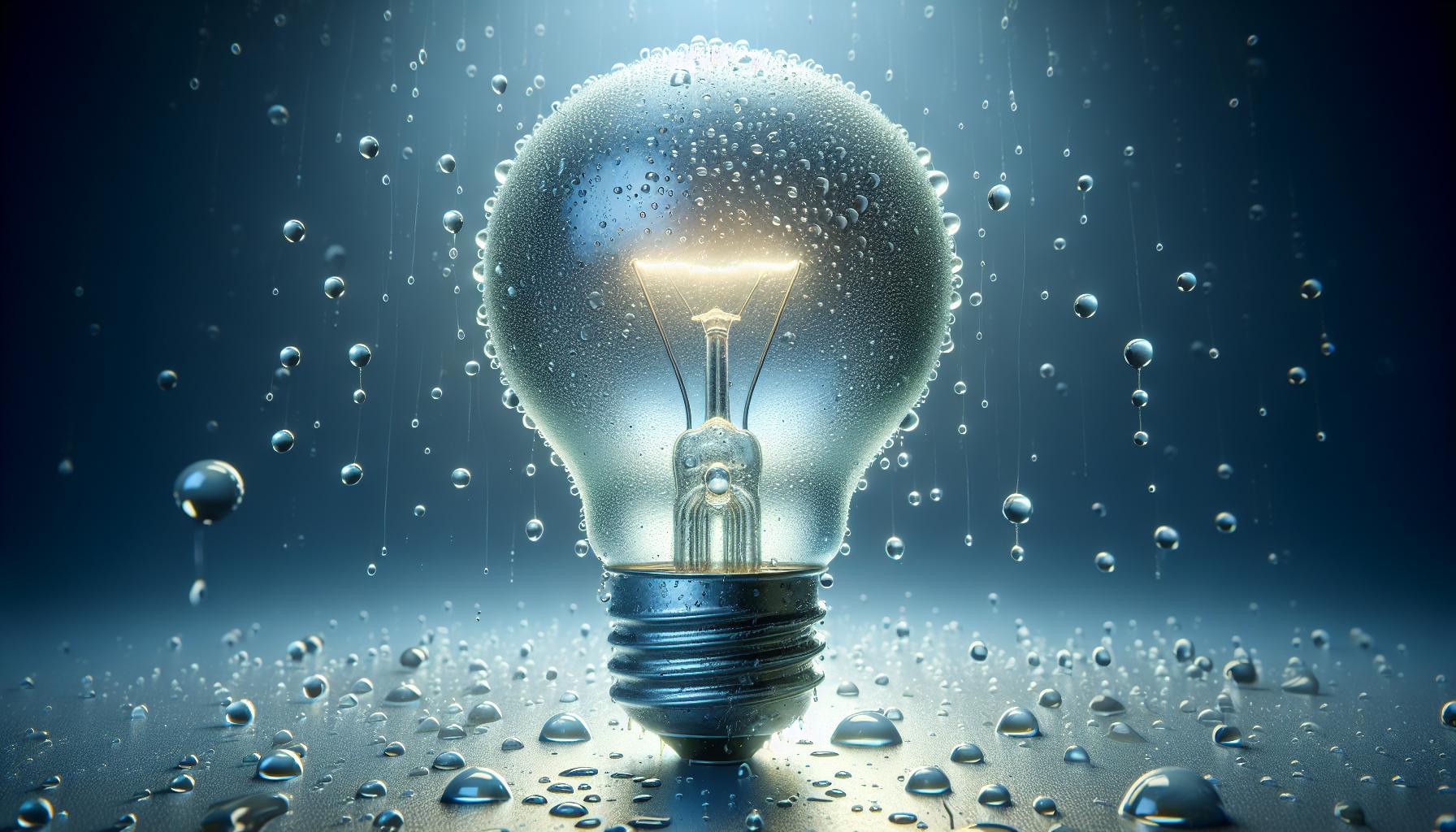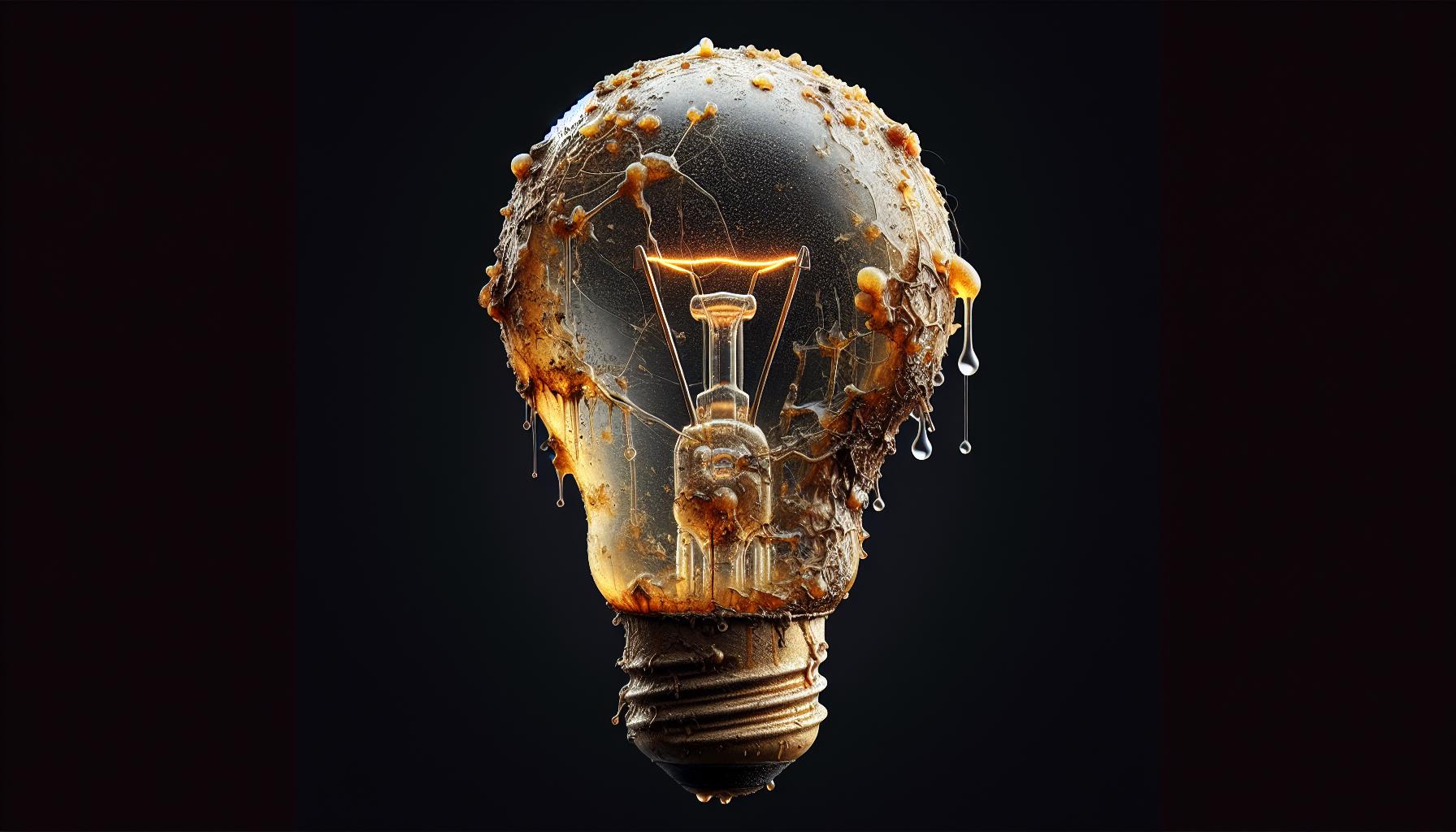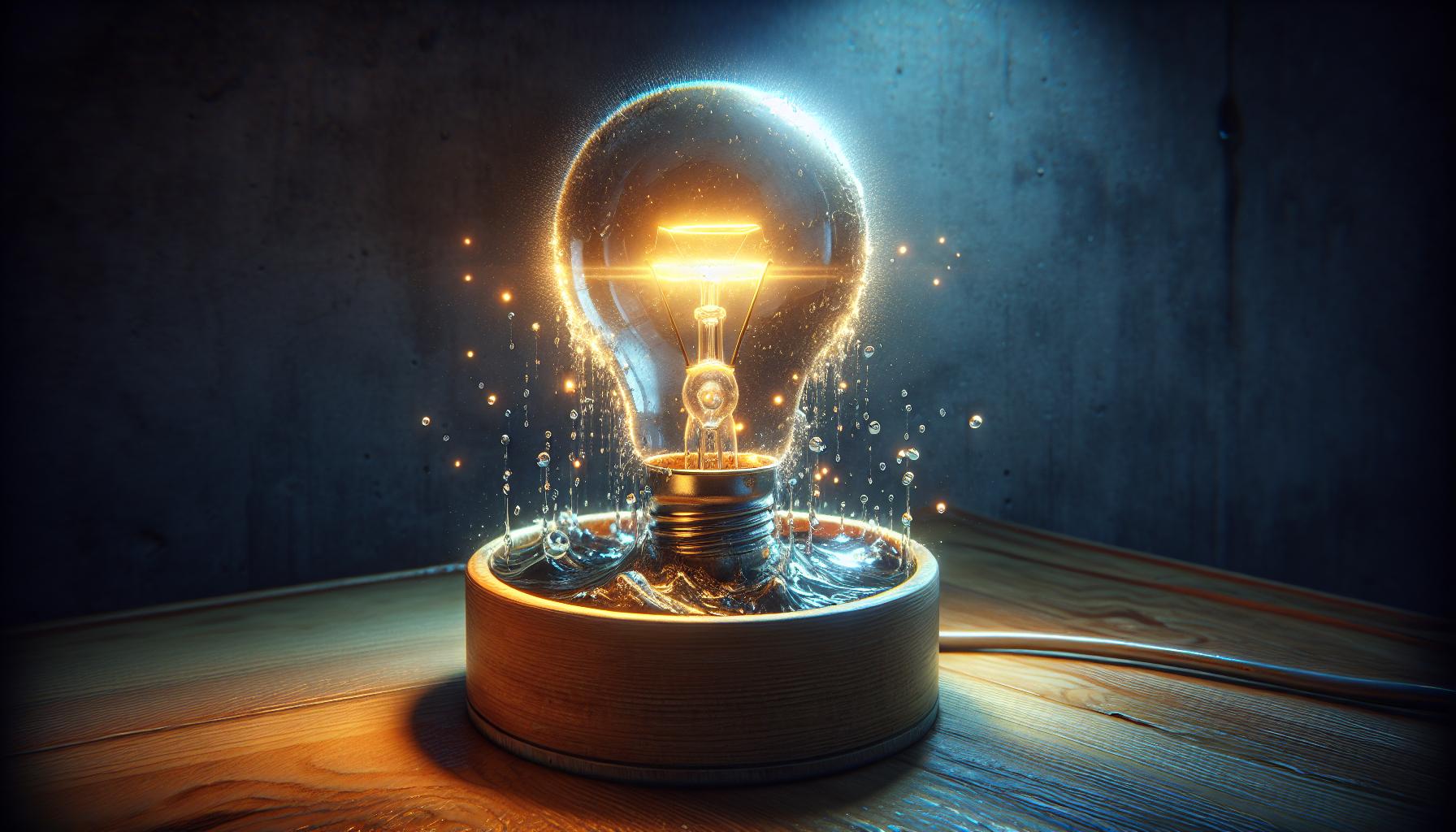Ever found yourself wondering what’d happen if your light bulbs got a little shower? Whether it’s a splash from a leaky roof or an accidental douse during spring cleaning, moisture and electronics don’t typically mix well. But before you panic, let’s dive into the nitty-gritty of wet light bulbs.

Water and electricity are a notorious duo for trouble. If your light bulbs get wet, you’re facing a few potential hazards. You’ve got to be cautious, because the outcome can range from a simple flicker to a full-blown electrical short.
Effects of Moisture on Light Bulbs
As an avid home DIY enthusiast, you’re aware that your projects can sometimes get messy. When you’re sprucing up your space, it’s important to understand how moisture can affect your light fixtures. If your light bulbs do get wet, they can react in a few different ways.
Water on a light bulb’s surface can cause it to cool down rapidly. Bulbs are designed to operate at high temperatures. When the hot glass meets cold water, it could lead to a crack or even shattering. This rapid temperature change is known as thermal shock. Here’s what can happen:
- The outer glass may crack, exposing the inner filaments.
- If the bulb shatters, the risk of injury from flying glass increases.
- Water can cause the metal base to corrode, leading to a poor connection with the socket.
In cases where water infiltrates the bulb, the situation can get complicated. The moisture inside can lead to an electrical short. This could actually trip your circuit breaker, cutting the power as a protective measure. It’s an effective warning that something’s not right with your electrical system. But before you reach for a towel to dry off a wet bulb, remember, safety first! Always turn off the power at the circuit breaker before touching wet electrical fixtures.
Moreover, even if the bulb doesn’t break or short immediately, repeated exposure to moisture can degrade the bulb over time. This can result in:
- Diminished lifespan of the bulb.
- Reduced efficiency as the bulb struggles to maintain its temperature.
Whether you’re dealing with incandescent, fluorescent, or LED bulbs, it’s crucial to keep them dry for optimal performance. Equip outdoor and bathroom fixtures with bulbs rated for these environments to prevent moisture issues. Additionally, well-sealed fixtures can provide an extra layer of protection against the inevitable splashes and humidity.
Remember that the key is to maintain vigilance and address any moisture issues promptly to ensure the longevity of your light fixtures. After all, the last thing you’d want is your bright ideas to go dim before their time.
Hazardous Effects of Wet Light Bulbs

When you’re dealing with light bulbs, it’s not just about ensuring they light up your space; you also need to look out for hazards that could impact your safety and that of your home. Water and electricity are notoriously dangerous when mixed, and light bulbs are no exception.
Electric Shock Risk grabs the spotlight here. Even a small amount of water seeping into the electrical components of a bulb can create a conductive path for the current. You might not notice it, but the water could energize the bulb’s surface, laying a trap that could give you a shocking surprise. It’s critical to remember that a wet light bulb isn’t just a concern for the bulb’s performance; it’s also a potential danger for anyone who touches it.
Next, consider the Thermal Shock. This occurs when the hot surface of a bulb comes into contact with water, causing it to cool down suddenly and unevenly. Light bulbs are not designed to handle such stress, and this can lead to fracturing or outright shattering. Picture the mess and hazard created by glass shards scatter everywhere—not something you want to deal with during your home DIY projects.
You also need to think about the Corrosion that can set in. Moisture may not always cause immediate failure, but over time, it’ll eat away at the metal parts. This corrosion can compromise the structural integrity of the bulb, leading to an unreliable connection or, worse, the bulb falling out of the socket.
Lastly, don’t forget about the Electrical Shorts and Circuit Breaker Trips. Water inside the bulb might form a bridge between the electrical pathways, allowing current to take a shortcut. This can trip your circuit breaker, and while that might seem like a minor inconvenience, it’s a clear sign of a safety mechanism responding to potential danger.
To keep the light in your life bright and safe, it’s crucial to address dampness and potential water intrusion spots around your bulbs. Look out for any signs of condensation, leaks, or outright spills and always prioritize safety when dealing with your lighting fixtures—especially if they’ve gotten wet.
Potential Risks of Water and Electricity Combination
« What Light Bulbs Are Best for Vanity? Discover Energy-Saving LED Options
Should Light Bulbs Explode? 8 Crucial Tips to Prevent Dangerous Mishaps »

When dealing with the precarious mix of water and electricity, you’re handling a volatile duo. The inherent risks are not only immediate but can also manifest over time, especially in household lighting.
Electrocution is the most dire risk when water comes into contact with electrical wiring or light bulbs. This can happen through direct contact or even moisture-laden air. If you’ve ever fiddled with a DIY lighting project, you know that safety comes first, so always ensure your hands and the workspace are dry before handling bulbs.
Short circuits occur when water acts as a conductor between two points in an electrical circuit that aren’t supposed to meet. It’s like accidentally connecting two puzzle pieces that don’t fit—suddenly, your masterpiece—a well-lit room, is plunged into darkness.
Gradual Deterioration
- Rust and corrosion affect the longevity of your bulbs and fixtures. They quietly eat away at the metal parts, diminishing the integrity and functionality of your lighting.
- Insulation breakdown can happen over time, starting a domino effect of electrical issues that you might not notice until it’s too late.
Unexpected Surprises
Believe it or not, bubbles can also form inside light bulbs. These are not the kind you’d delight in popping but rather the kind that signal danger. Water inside the bulb can boil when heated, creating steam and pressure that may lead to the bulb shattering. It’s not the sort of light show you’d want to experience.
Keeping your lighting away from water is much like keeping your DIY tools in top shape; it’s essential for their performance and life span. Regular checks for any moisture build-up or signs of water damage around your lighting fixtures can save you from a spectrum of electrical woes. Keeping every light bulb and fixture dry is not just about efficiency—it’s also about your safety and peace of mind.
Flickering as a Sign of Wet Light Bulbs

Imagine you’re enjoying a quiet evening at home, and suddenly, your living room lamp begins to flicker. It’s easy to assume it’s just a faulty bulb, but flickering can be a warning sign that your light bulbs have been exposed to moisture. As a lighting enthusiast with a knack for DIY, you understand the importance of addressing this issue promptly.
Electricity and water are a hazardous duo, where water’s conductivity increases the chances a circuit will short. Flickering can occur when water droplets, big or small, find their way into the fitting. This might seem benign, but it’s signaling a potential threat. The faster you respond, the higher your chance of mitigating risks.
- Ensure the power supply is off before investigating.
- Check for any visible moisture around the bulb or fixture.
- Allow any detected wetness to thoroughly dry before restoring power.
Regularly inspecting the seals of outdoor lights or bathroom fixtures is a smart practice. Over time, seals can degrade, allowing moisture to creep in uninvited. Consider this a part of your routine home maintenance, just like clearing gutters or checking smoke detectors.
For those adventurous spirits eager to fix all on their own, remember that electrical repairs aren’t standard DIY. If the problem seems to stem from more than just a wet bulb—maybe it’s faulty wiring or a compromised fixture—call a professional. Safety should always be your priority.
In the case of flickering lights, being proactive pays off. It keeps your home safe and ensures those chosen light bulbs—perhaps carefully selected for their color temperature or lumens—continue to cast the perfect glow over your living spaces. After all, as someone who appreciates the finer details in home décor, preserving the ambiance is as important as fixing the issue at hand.
Electrical Short Circuit Due to Wet Light Bulbs

You know that electrifying feeling of accomplishment when you’ve nailed a DIY project at home? It’s the same spark that fires up when you’ve fitted the perfect light bulb to set the mood. But, if light bulbs get wet, that spark can turn into something far less enjoyable: electrical short circuits.
When moisture invades the sacred space of a light bulb’s electrical system, it paves the way for unwanted electrical paths. Water, being a good conductor of electricity, can create a bridge between wires that should never meet. This can cause excessive current flow, leading to overheating and potentially even fire. The drama doesn’t end there; if you’re handling a light fixture and it shorts, you’re at risk for a good jolt—or worse, electrocution.
Do you ever notice a mysterious tripping of your circuit breaker? It might just be a tell-tale sign that a wet bulb is playing havoc with your electrical system. The circuit breaker tripping is actually a lifesaver disguised as an inconvenience—it’s cutting power to prevent damage and keep you safe. However, don’t just flip the breaker back on and forget about it. You’ve got detective work to do.
To sleuth out the moisture-ridden culprit, focus on areas prone to dampness. Your outdoor lighting, bathroom, and basement fixtures are prime suspects. Seals can degrade over time, and those once water-tight defenses might falter, allowing moisture in like an unwelcome guest. It’s these very seals that you should check regularly to ensure they haven’t lost their integrity.
Remember, be vigilant with your light fixtures and bulbs; keeping them dry isn’t just a maintenance mantra, it’s a safety cornerstone. Engage in routine checks and replace any seals that seem suspect. And, if you encounter a flicker or breaker trip, don’t ignore it. Instead, investigate it—your peace of mind and safety may well depend on it.
Conclusion
Remember, water’s a no-go for your light bulbs. Staying vigilant and proactive can save you from a world of electrical woes. If you spot a flicker, don’t just hope it’ll go away—take action. Keep your fixtures dry, inspect them regularly, and never hesitate to call in the pros when things seem amiss. By keeping an eye on moisture and addressing any issues promptly, you’ll keep your home safe and your lights shining bright. Stay dry, stay safe, and let your light bulbs do what they do best—illuminate your space without a spark of trouble.
Frequently Asked Questions
What are the main risks associated with water and electricity in light bulbs?
Water exposure can lead to electrocution, short circuits, rust and corrosion, insulation breakdown, and bubbles formation inside light bulbs. Ensuring fixtures are dry is crucial for safety and preventing electrical issues.
What is a sign that light bulbs may have been exposed to moisture?
Flickering lights can indicate that light bulbs have been exposed to moisture. This should be checked for and addressed promptly to avoid potential safety hazards.
What should you do if you suspect moisture in a light bulb?
If you suspect moisture in a light bulb, turn off the power supply before investigating. Check for visible moisture and let any wetness dry thoroughly before restoring power to the fixture.
Why is it important to inspect lighting fixture seals regularly?
Regular inspection of lighting fixture seals is important because it helps to prevent moisture from entering and causing electrical issues, such as short circuits and rust, which can compromise safety.
What could happen if a light bulb gets wet and causes a short circuit?
If a light bulb gets wet and causes a short circuit, it can lead to excessive current flow, overheating, and in severe cases, fire. It’s essential to check damp-prone areas and maintain seals to prevent such hazards.
How can I maintain a safe home environment regarding light bulbs and moisture?
Maintain a safe home by regularly checking light fixtures for moisture, especially in damp areas. Investigate any flickering lights or tripped circuit breakers immediately. Consult a professional for electrical repairs to safeguard against risks associated with wet light bulbs.




